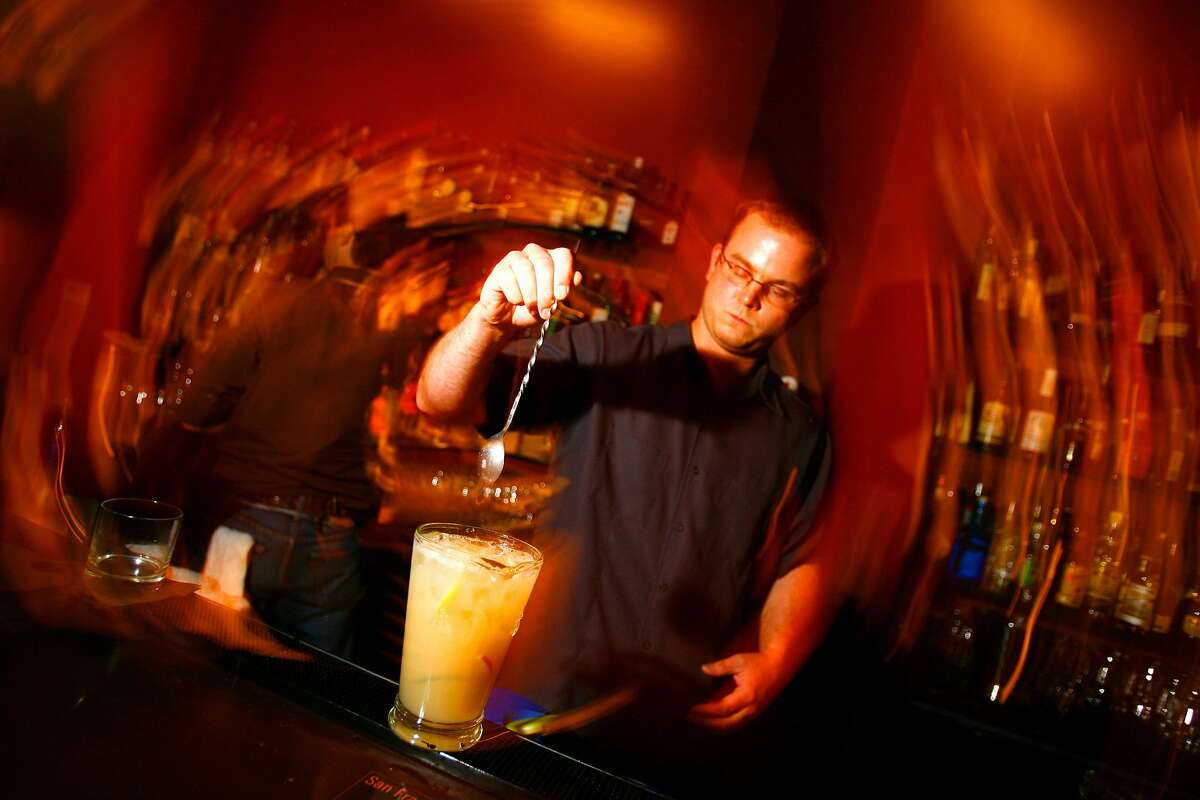This is a carousel. Use Next and Previous buttons to navigate
Early San Francisco’s most famous cocktail was Pisco Punch. From the Gold Rush until Prohibition, this secret concoction was the preferred beverage of discerning tipplers.
But when the legendary bar where it was invented closed, and the bar’s equally storied bartender refused to divulge its recipe, Pisco Punch vanished from the Earth. It remained in cocktail limbo for half a century, until an enterprising historian exhumed what he claimed was the original recipe.
这是一个发现足够的显著性e that it merited a full-length article in a leading academic journal of California history — proving, if nothing else, that San Francisco has always taken its drinking seriously.
Pisco Punch was created at old San Francisco’s most renowned saloon, the Bank Exchange, which opened in 1854 in theMontgomery Block.The bartender inextricably associated with the cocktail was a courtly Scot named Duncan Nichols, who dispensed Pisco Punches from the 1870s until the bar closed in 1920.
In his 1948 book, “This Is San Francisco,” Robert O’Brien writes that according to legend, a dying stranger Nichols had befriended “imparted to him the secret formula of a rare punch that went down as lightly as lemonade and came back with the kick of a roped steer. Its basic ingredient was a brandy made of a Peruvian bark.”
Although the dying stranger tale was an excellent creation myth, the more prosaic truth was that Nichols inherited the recipe from the bar’s original owners. In any case, he and his cocktail became so popular that he was called “Pisco John,” and the Bank Exchange became known as Pisco John’s. A contemporary reporter wrote, “Step into the foyer of the Hotel Cecil in London and inquire in a loud voice the location of ‘Pisco John’s’ and from a dozen throats will come the reply: ‘Southeast corner of Montgomery and Washington streets, San Francisco, America!”
Pisco Punch inspired litterateurs who imbibed it to memorable rhetorical heights. In his 1874 book, “Underground, or Life Below the Surface,” Thomas W. Knox wrote, “The first glass satisfied me that San Francisco was, and is, a nice place to visit. The second glass was sufficient, and I felt I could face smallpox, all the fevers known to the faculty, and the Asiatic cholera combined, if need be.”
Rudyard Kipling penned one of the all-time greatest encomiums to a drink after sampling another Peruvian brandy-based drink served by Nichols, Button Punch: “I have a theory it is compounded of cherub’s wings, the glory of a tropical dawn, the red clouds of sunset, and fragments of lost epics by dead masters.”
Almost all accounts of Pisco Punch assert that it was a beverage of remarkable potency. In “Sumptuous Dining in Gaslight San Francisco,” Frances de Talavera Berger and John Parke Custis called it “the most lethal alcoholic bomb ever conceived by man.” O.P. Sidgens, manager of the Montgomery Block and a regular at the Bank Exchange, likened it “to the scimitar of Harroun, whose edge was so fine that after a slash a man walked on unaware that his head had been severed from his body until his knees gave way and he fell to the ground dead.”
And in “San Francisco’s Wondrous Drink, Pisco Punch,” an article that appeared in the Fall 1997 Argonaut, Paul Scholten wrote, “In Lima, it is said that after you have had one Pisco Sour you immediately want another. After you have had two, you feel like another person; so you have two for him. Once again, you feel like a new man and have two for him. By that time you can speak Quechua, the Inca language, or at least a tongue equally incomprehensible.”
Since Peruvian brandy is no higher proof than any other standard liquor, these assertions must be taken with several grains of margarita salt. But they helped burnish the drink’s legend.
Of course, what assured that legend was the fact that only Nichols knew Pisco Punch’s ingredients. Not even his own employees knew how he made it: He mixed batches of the elixir in the Bank Exchange’s cellar and sent them upstairs on a dumbwaiter.
When the bar was closed by Prohibition in 1920, reporters badgered Nichols for the recipe, but he refused to talk. When he died in 1926 at the age of 72, he took the recipe with him to the grave. As Idwal Jones mournfully wrote in his 1951 book, “Ark of Empire,” the secrets of Pisco Punch “are now as much lost as Tyrian purple and the art of tempering copper.”
Then, in 1964, historian William Bronson entered the picture.
Every corner in San Francisco has an astonishing story to tell. Gary Kamiya's Portals of the Past tells those lost stories, using a specific location to illuminate San Francisco's extraordinary history - from the days when giant mammoths wandered through what is now North Beach to the Gold Rush delirium, the dot-com madness and beyond. His column appears every other Saturday.
Bronson’s Pisco saga began when a lawyer friend named A. Crawford Greene asked him to write Greene’s memoir. As Bronson writes in “Secrets of Pisco Punch Revealed,” which appeared in the fall 1973 issue of the California Historical Quarterly, in looking through Greene’s papers in the Bancroft Library, he came upon an exchange of letters in which Greene sent a friend a recipe for ... Pisco Punch!
The recipe was written by a man named John Lannes, who Bronson discovered was the manager of the Bank Exchange in 1920. Greene wrote that an old-time colleague told him that Lannes’ version of Pisco Punch “tasted exactly” like Nichols’ original.
Bronson speculated that Lannes had learned which ingredients were coming into the bar and spied on Nichols as he mixed the casks.
The recipe’s key ingredient is gum arabic, a thickening agent that somehow takes the rough edges off Peruvian brandy. However Lannes came by it, he may have stumbled upon one of San Francisco’s gustatory Holy Grails.
Here is Lannes’ recipe for Pisco Punch, as reported by Bronson:
• Take a fresh pineapple. Cut it in squares about ½ by 1½ inches. Put these squares of pineapple in a bowl of gum syrup to soak overnight. That serves the double purpose of flavoring the gum syrup with the pineapple and soaking the pineapple, both of which are used afterward in the Pisco Punch.
• In the morning, mix in a big bowl the following:
Half a pint (8 oz.) of the gum syrup, pineapple flavored as above.
One pint of distilled water.
Three-fourths of a pint of lemon juice.
One bottle (24 oz.) Peruvian Pisco Brandy.
Serve very cold, but be careful not to keep ice in too long because of dilution. Use 3 or 4 oz. punch glasses. Put one of the above squares of pineapple in each glass. Lemon juice or gum syrup may be added to taste.
Today, some version of Pisco Punch is served in a number of San Francisco hostelries. But since no one will ever be able to prove whether Lannes’ or any other recipe is authentic, this blast from the alcoholic past will remain in a (highly appropriate) state of pleasant confusion.
Gary Kamiya is the author of the best-selling book “Cool Gray City of Love: 49 Views of San Francisco,” awarded the Northern California Book Award in creative nonfiction. All the material in Portals of the Past is original for The San Francisco Chronicle. To read earlier Portals of the Past, go tosfchronicle.com/portals. For more features from 150 years of The Chronicle’s archives, go tosfchronicle.com/vault. Email:metro@sfchronicle.com





















